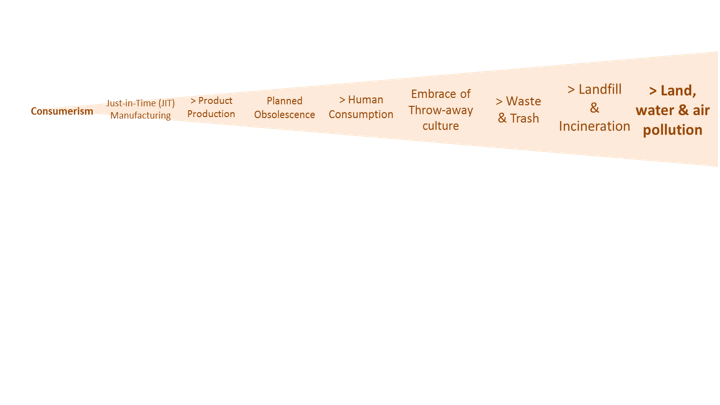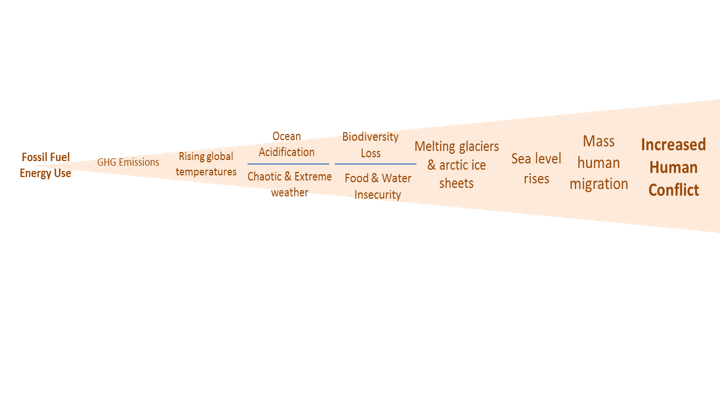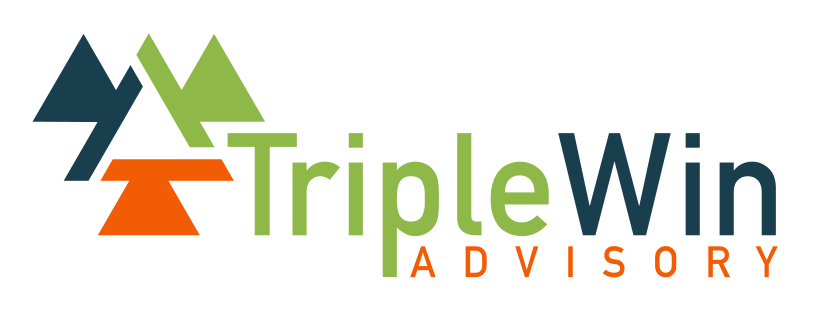Systems Thinking and Tackling Complexity
It is important to understand a concept of systems thinking as it applies to planetary climate change. That concept is ‘feedback loops’. Systems thinking is an analytical approach to understanding complex problems within a defined system (e.g., the federal government, a city, a corporation, a family unit) where interactions within the system are relationship-based, interdependent, complex and varied in both cause and effect. Simple, easy solutions are inadequate for solving problems within a ‘system’. This is definitely true as problems grow to global proportions. Think about greenhouse gas (GHG) emissions and their effect on global temperature rises. Every country needs to work towards the reduction of GHGs in its purview but no one country can make a difference unless all (or the majority of polluting countries) work toward the same goal.
Complex Problems Demand Parallel, Iterative Solutions
The case of Over-Fishing
Another aspect of systems thinking is tackling complexity within a system. There is often no one right answer and no one right approach to solving a system’s problems. In fact, solution-setting needs to be iterative, continuous, often conducted in parallel, and refined or abandoned as data reveals where efficacies reside. Think about the world problem of overfishing and fishery depletion. This is a problem we (as humanity) continue to face. Increases in global fish consumption since the 1950s have depleted our ocean waters of fish species that many human populations rely on for their primary source of protein. Overfishing disrupts the natural biological food chain in oceans. As highly popular top predators of the ocean (e.g., tuna, grouper) are fished to near extinction, the marine food chain invariably changes to allow for an abundance of smaller species to thrive, such as sardines and anchovies.2
What are the solutions to the over-fishing problem?
For one, global governance of international waters. The problem is no one person or nation “owns” the world’s oceans and thus, they are prone to illegal fish pirating. Another, is local or shared governance (e.g., between governments, NGO’s and local communities) of fisheries to combat pirating. They unfortunately, have had sporadic success due to rules implementation and ownership issues. Third is a new fish ‘industry’: aquaculture (breeding popular fish species in captivity such as Salmon, Oysters, and Shrimp). Aquaculture supports wild fish catch management but has its own serious environmental impacts to wetlands and natural estuaries with issues such as fish waste management and (over)use of antibiotics.
The Feedback Loop and Complex Systems
In complex systems, many solutions need to be thrown at a problem, in parallel, and some solutions create their own set of problems, requiring problem-solving pivots to occur in order to analyze the overall global problem anew. What does all this have to do with so-called ‘feedback loops’?
Feedback Loops
A feedback is the identification of an impact from a process where there are both input(s) and output(s) to that process. In clothing manufacturing:
· Inputs would be the raw materials such as fabric, zippers and buttons,
· The Process would be the fabric cutting, sewing, ironing, and packaging,
· Output would be finished “goods” such as a pair of socks, a shirt, or a sweater.
A ‘feedback loop’ is when the output from a process becomes a process input. A closed-loop example of an output that becomes an input would be recycled glass bottles made into, say, a glass vase.
Two types of feedback loops exist: positive and negative. Positive feedback loops are self-reinforcing, momentum-gaining, powerful amplifying loops that are difficult to manage if not stop. They should not be thought of as our ideal or preferred. Positive feedback loops “are sources of growth, explosion, erosion, and collapse in systems. A system with an unchecked positive loop ultimately will destroy itself.”1 In fact, of the two types of feedback loops, positive ones have a tendency to be the most threatening to humanity. Because of the gaining strength of positive loops, their effects become amplified and even, run-away.
Towards Using Feedback Loops to Tackle Climate Change
Think again about climate change. As global GHG emissions continue to increase and accumulate in our atmosphere (which they most definitely are), the Earth’s temperature rises. With these rises come a cascading number of problems that fuel even greater climate change and chaos within our climatic system with damaging albeit some, unknown effects to the planet’s hydrologic (water) cycle. Glaciers and arctic ice sheets melt. Sea waters rise. Air temperature warms and holds more moisture. Weather becomes more erratic and extreme. This temperature amplification could continue to melt arctic tundra releasing untold stores of methane gas, more harmful and longer-lasting than CO2 emissions, warming the air and earth at an even faster rate so that the possibility of dramatic sea level rises (14 feet instead of 3-4 feet) and a dramatic slowing or stopping of the ocean’s ‘conveyor belt’ become more likely. Unchecked increases in earth’s global average temperatures have a cascading effect on processes that currently stabilize the planet’s climate, and once unleashed, allow climate change to run rampant and out of the control of human mitigation efforts. This is an amplifying, run-away positive feedback loop with potentially dire consequences to humanity and other species on earth.
Negative Feedback Loop – Danger or Opportunity?
A negative feedback loop is a natural or human-invented mechanism for reducing initial effects of a process. At the core, negative loops self-correct and limit a processes output so that a system stays in balance. The well-known Malthusian negative feedback loop was one where as world population grows, human consumption (of food) increases, and food scarcity becomes a reality, which leads to famine/starvation and ultimately death. The feedback loop is the process of keeping the human global population in balance with the ability of the earth’s ecosystem to feed humanity.

Other examples of negative feedback loops include: As outside temperatures rise, at some set temperature level, a house’s air-conditioning turns on to keep inside temperatures from becoming unbearable. The same goes for heat. At some point, as temperatures drop, a house’s heat system turns on so that its inhabitants don’t freeze or become unduly and dangerously cold.
Another negative feedback loop is when industry GHG emissions that create smog, acid rain and air pollution that affect people’s health and wellbeing, are regulated so that either with the deployment of new technology (that mitigates GHG emissions into the atmosphere) or through government incentives that promote the adoption of renewable forms of energy that are non-GHG emitting, air pollution declines and air quality improves. Most negative feedback loops are beneficial in form; developed to better the human condition and to prevent run-away positive feedback loops from occurring. Having the new Administration announce its goal to repeal regulation on polluting GHG industries is a good way to sabotage a regulating negative feedback loop and effectively worsen the human condition.
We are living in a time of a great many positive feedback loops occurring concurrently: amplified problems that are complex, challenging, not easily remedied, with many interlinked factors at play.
Here are a few:
Consumerism driving Pollution

Fossil Fuel Energy Use driving Ecosystem Collapse

Look for the Crucial Variable in the Loop
Think from a systems perspective on the great many variables at play that need tinkering to make significant, long-lasting changes in either of the examples above. From the consumerism example, manufacturing should return to the idea of making a great product to last a lifetime. Repair is part of any product lifecycle. End-of-life product design should be implemented so that any product made is recaptured and recycled into its “newest” version of itself with little to no “raw” or “virgin” materials incorporated. Planned obsolescence should not be a practice employed and should in itself, become obsolete in use. Thought should be on what, how much and how items make it to landfills or get incinerated. The ideas around biological versus technical nutrients espoused by McDonough and Braungart in Cradle to Cradle are worth a read or two. The mitigation and prevention of pollution to water will ensure that water resources are available for human consumption and agricultural need; to land so that our soils are fertile and productive as well as reinforce human health; and to air so that we can breathe and thrive.
In everyday parlance, negative (loops) are better than positive (loops), counter-intuitive to the base definitions of ‘positive’ and ‘negative’. At every turn, climate change solutions should seek to better the human condition on whole: not for a portion of workers; not for one particular industry sector; and not for just one country. On whole: we should all be in this climate change fight together – offering solutions in parallel, iteratively, that are tested, refined, and even abandoned, once determined they are ineffective or cause worse problems than they intend to solve
Contact Kate Gaertner today to see what Triple Win Advisory can do to help your business and industry increase sustainability to result in a “triple win” for company profit and long-term competitive advantage, societal well-being, and successful environmental pollution mitigation.
Kate Gaertner
References:
1Meadows, Donella H. (1999, December). Leverage Points: Places to Intervene in a System. Sustainability Institute.
2World Wildlife Fund. (2017). Threats: Overfishing: Overview. Retrieved at https://www.worldwildflife.org/threats/overfishing
Cato, Molly Scott. (2011). Environment and Economy. London, U.K., Routlage, p. 138-141.
Harris, Jonathan M.; Roach, Brian. (2013). Environmental and Natural Resource Economics: A Contemporary Approach. Armonk, New York, M.E. Sharpe, p. 448.
[print_link]
